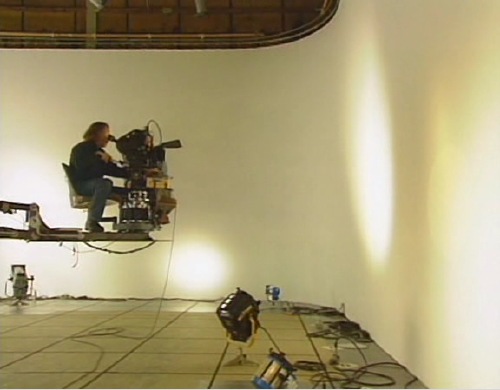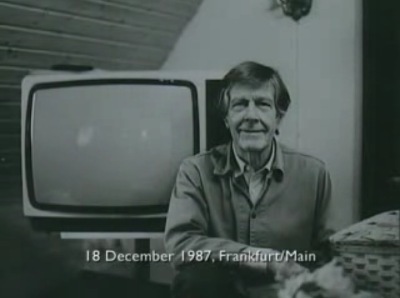
A couple of weeks ago, I watched Henning Lohner’s film essay/documentary about working with John Cage to make One11 and 103, Cage’s only feature film project, completed just before he passed away in 1992.
It’s on YouTube, chopped up in several parts, and mostly in German [One11 and 103 was made for German TV], but now Ubu has posted the English version, so you non-Germans can actually figure out what’s going on. [ One11 and 103 is online, too, though it has the 3sat logo burned into the upper corner, which turns the whole thing into a 90-minute promotional bumper for the station.]
For One11, Cage and his collaborator Andrew Culver used a computer program to generate a series of chance operations, instructions for light placement and movement within an empty soundstage; for camera movement and positioning; shot length; and for editing.
Narrative- and nearly content-free, the 17-segment film was accompanied by 103, a 17-segment orchestral composition that was also based on chance operations. The film’s title follows Cage’s numbering system: the eleventh composition for one performer, in this case, the camera man. So while Cage explains the film as being “about the effect of light in a room,” it’s also very much about the perception, movement, and recording of the cinematographer, Van Carlson.

Cage made the point to Lohner early on that his idea wouldn’t “waste” any film. And sure enough, it turns out the final shooting ratio was an astonishing 1.4:1, with less than 600 meters of extra footage–which, we are told, was used in the opening and closing credits. It’s almost like Cage went to film school during the Depression.
The obvious appeal of an abstract light show aside, watching all this self-conscious randomness [I’ve been going through and replacing “random” with “chance,” since that’s the specific term Cage uses. I think there’s a meaningful difference.] really puts the conscious decisions of location and content into high relief. It also makes me want to remake One11 in another environment and see what happens. I’d also wonder how many more decisions could be randomized, and to what effect? Eventually, if you put a decision factor into play, the randomness of it will generate a distinctive effect, if not an actual style. It’s one of the conundrums of Cage’s work that I like picking through.
One11 and 103: the making of [ubu.com]
You know, at $27, it wouldn’t kill you to buy Mode Records’ DVD version of John Cage: One11 with 103, either, from The Complete John Cage [amazon]
NOW THAT I THINK ABOUT IT UPDATE: You know, posting this really seems like a departure for Ubu. I mean, Ubu began posting vintage, impossible-to-buy-or-even-find works, but with One11 and 103, they basically ripped a commercial DVD published in 2006 by a small, well-known, high-quality independent publisher of modern music. Am I missing something here?
UPDATE UPDATE: Yeah, Ubu’s versions of both One11 and Making of One11 first appeared on The Sound of Eye, an equally amazing art film and experimental music blog, albeit one with a different approach to posting works that are readily available in the commercial market. Ubu announced a collaboration with Sound of Eye a little while ago.
Skip to content
the making of, by greg allen
